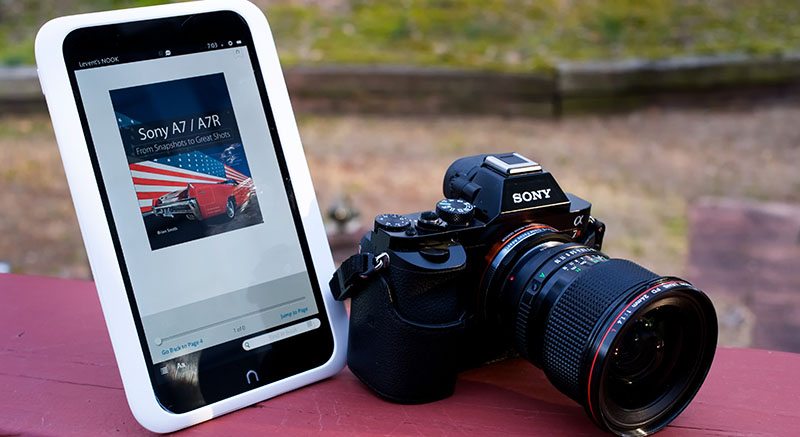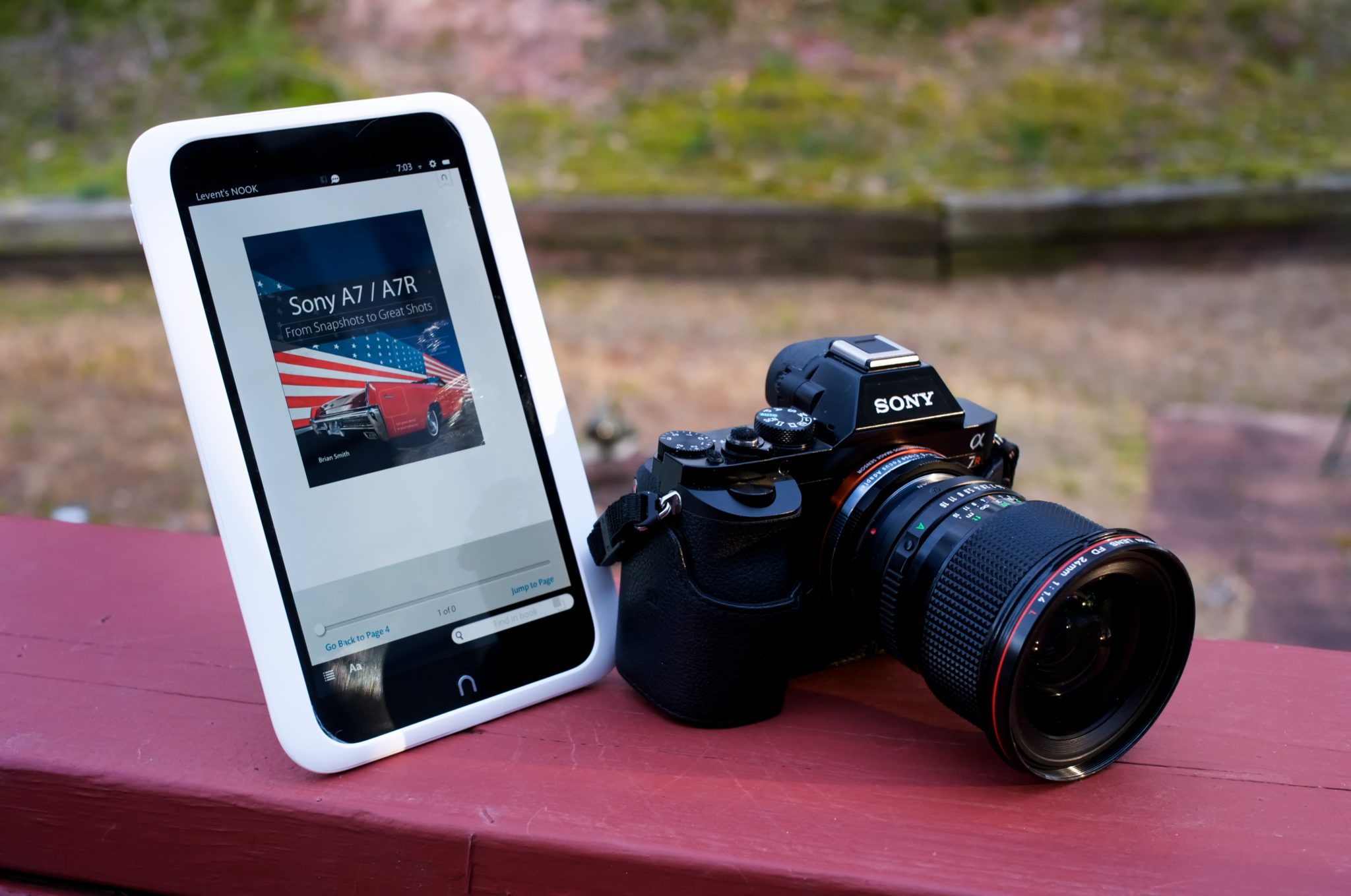Sony A7 / A7R: from Snapshots to Great Shots


A TWiP book review by Levent Cimkentli
A few years ago the Sony Corporation had publicly stated that they hoped to become a major player in the field of digital photography. This however would mean that they would have to compete head-to-head against the big two camera makers, namely Canon and Nikon. Needless to say, the entrenched user base, high performance and deep range of lenses offered by these two venerable brands has made Sony's quest an uphill battle, especially in the professional sphere.


With the release of the A7 and A7R, Sony has brought to market the world's first full-frame mirrorless interchangeable lens auto-focus cameras. To be fair there are other mirrorless cameras, but with the exception of the Leica M, they all have smaller sensors. The physical characteristic of the smaller sensor limits certain factors such the shallowness of depth of field and low light performance. And while the Leica M does indeed have a full-frame sized sensor, it's rangefinder design, makes it incapable of auto-focus.
It is possible that the A7 and A7R, as well as their future successors might enable Sony to break away from the rest of the pack and perhaps someday reach the top of the field. The reason being the ever increasing fusion of still imaging and videography. A trend that will no doubt expand as commercial clients demand moving images for their various media outlets and the desire by regular folks to have greater flexibility in image capturing devices.
It seems that with the built in electronic viewfinder, coupled with live view, mirrorless cameras are more or less video cameras that happen to take still pictures. Contrast this with the DSLR's, whose mirror assembly and optical viewfinder makes it difficult to properly shoot video, without a slew of ancillary gear. Furthermore most mirrorless cameras have the ability to shoot video with auto-focus enabled.
While it is true that DSLR's can be made to shoot superb video images without auto-focus when utilized in a cinematic style production. For many day to day uses, auto-focus video can be advantageous, especially as cameras are beginning to combine facial recognition with electronic focusing. To reemphasize my point, the A7 and A7R cameras are wholly unique and do not directly compete with anything currently on the market.
To be honest, the Sony A7 and A7R have many flaws, such as a less than stellar video codec and ergonomic oddities. But these cameras should be judged as a first generation product. They are Sony's initial attempt at creating a camera that represents the future of photography. Their biggest achilles heel is the dearth of lenses in the native “FE” mount.
As a stop-gap measure Sony is highlighting the fact that you can use a wide range of non-native lenses via adaptors (often with very good results). Furthermore Sony is committing considerable resources to release a comprehensive range of lenses as soon as possible. It is unknown whether or not Sony can make a full range of lenses, before Canon and Nikon wake-up from their collective DSLR slumber and create a competing mirrorless full-frame camera.
In terms of marketing, it is helpful for Sony to have an exclusive coterie of well-known professional photographers who use their cameras and lenses. Basically such people are brand cheerleaders, who promote the products by appearing at trade shows, teach at company sponsored workshops and blog about the products.
The overall premise being that, if a camera is good enough for an admired professional, then it is certainly good enough for everyone else. Along this line Nikon sponsors such a group, whom they call “Ambassadors”, Canon calls them “Explorers of Light”‘ and Sony's group is called the “Artisans of Imagery” and one of their “Artisans” is a man named Brian Smith.
Mr. Smith is a Pulitzer-Prize winning photographer, who has been working professionally for more than 30 years. His career runs the gamut from travel, sports, journalism, advertising and most recently the tony field of celebrity portraiture. In March 2014, Peachpit Press published Brian Smith's latest book “Sony A7/A7R from Snapshots to Great Shots.”
Topping out at 336 pages, it retails at $29.99 for either the print edition or a downloadable trio of digital formats (PDF, MOBI & EPUB). At press time this book can be purchase at a bit of a discount on the Peachpit website, and it also is sold in the Amazon Kindle's proprietary format for $16.19.
Regarding this book the Peachpit website says the following:
“While the camera manual explains what the camera can do, it doesn't show exactly how to use the camera to create great images! That's where Sony A7 / A7R: From Snapshots to Great Shots comes in”.
After having read this book cover to cover, I am of the opinion that Mr. Smith succeeded in his task. I should however preface this by making the observation that books such as these are quite difficult to write because they essentially have two audiences: beginners with limited photographic knowledge and experts need a primer that gets them up to speed on a specific camera.
This means that in order to be truly useful to the latter, the book must teach basic photographic concepts such as: the exposure triangle, focal length, reading a histogram, etc. But at the same time it must offer tips that make it valuable to the advanced user, without overloading the pages with basic techniques to the point where you are paying to re-read what you already know in your bones.
Thankfully Mr. Smith has found a perfect balance. The fundamentals of photography are indeed taught, very clearly, without overdoing it. The editors and graphic artists did a fine job of giving it a clean layout, crisp text and a spit and polish that is the hallmark of a professional publishing house.
I am pleased to report that there is quite a bit of information in this book that is of value for the advanced photographer. Bear in mind, modern cameras are basically computers that capture images. Furthermore with each iteration: the user interface, menu system and features can vary greatly.
This means that it can take a while for an operator to be proficient with the controls and capabilities of a new device. The intimate understanding of these controls and features also needs to be filtered within the context of making an actual picture and not just a hypothetical or vague notion of an photo. These Sony's are the first of a new kind of camera and frankly there is not a lot of information from a truly authoritative source.
Yes, there are various online camera reviews, blogs and forums talking about the A7 and A7R. But, sadly much of what is online is a hodgepodge of conflicting information. Thus, amid the camera centric cacophony it is hard to separate the proverbial wheat from the chaff.
In other words it helps to get an expert at taking pictures, who seriously focuses his efforts at learning and expressing what is important about a specific camera as it pertains to artistic expression. I should also point out that according to reports, Brian Smith was given these cameras about two weeks before they were officially announced. So he probably has more experience with these Sony's than anyone in North America.
Much of the book, follows the well-worn format of collegiate textbooks, with chapters beginning with lessons and concluding with assignments which are basically a way to reinforce what was previously taught. Among the things I especially enjoyed was the chapter in which he tells us how he sets up his camera and more importantly WHY he chose those settings.
I suspect my shooting style is very different from the author, but with the complexities of camera menu systems being what they are, I like the insight garnered from a person who is in position to get information directly from Sony's product managers and engineers.
It is especially refreshing to read that when the author perceives a flaw or shortcoming of the A7 and A7R he brings it up without reservation, despite his connection with the manufacturer. Thus showing him to be a fair arbiter, whose primary intent is to simply explain how to take great pictures with this tool.
For instance in a chapter that describes the “Intelligent Auto” modes, Mr. Smith says that when in Macro mode the camera automatically sets the lens at the widest aperture and sets the shutter speed fast enough to avoid blur, BUT it also sets the ISO to make the proper exposure. He then points out that if the scene is too dark, the camera could raise the ISO to the point where the noise level is unacceptable. Perhaps Sony might fix this flaw in a future firmware update. But in the meantime it's an important thing to be aware of, if you use the Macro mode.
As expected Brian Smith is a fine photographer with a lot of experience in a variety of fields and in my opinion one of the better aspects of this book that transcends its camera specific utility is something he calls “Poring Over the Picture.” This feature which is repeated throughout the tome, consists of a large blow up of one of his shots, with superimposed bullet points that have various interesting comments about the image, that clearly illustrates why a good photo is truly the sum of its parts.
Also he has especially good chapters on photographic composition, as well as various chapters with great tips on Portraiture, Sports, Landscape, Street Photography and intriguingly a chapter he calls “Mood Lighting” which covers dawn and dusk landscapes and portraits in tricky lighting situations. Frankly I cannot take issue with any of his advice, as it all seems to be pretty rock solid.
The final chapters cover a plethora of short chapters with basic advice on using the camera with strobes, non-Sony optics such as SLR and Leica rangefinder lenses by way of adaptors, HDR photography, tethering, shooting video and the use of various accessories.
In the introduction to the book Brian Smith stated that his book is not a substitute for the users manual, but it is instead a companion volume to be used as a supplement. I wholeheartedly agree with his sentiment and at its reasonable asking price, I found my purchase to be a fine way to get the most out of these intriguing new cameras.

















